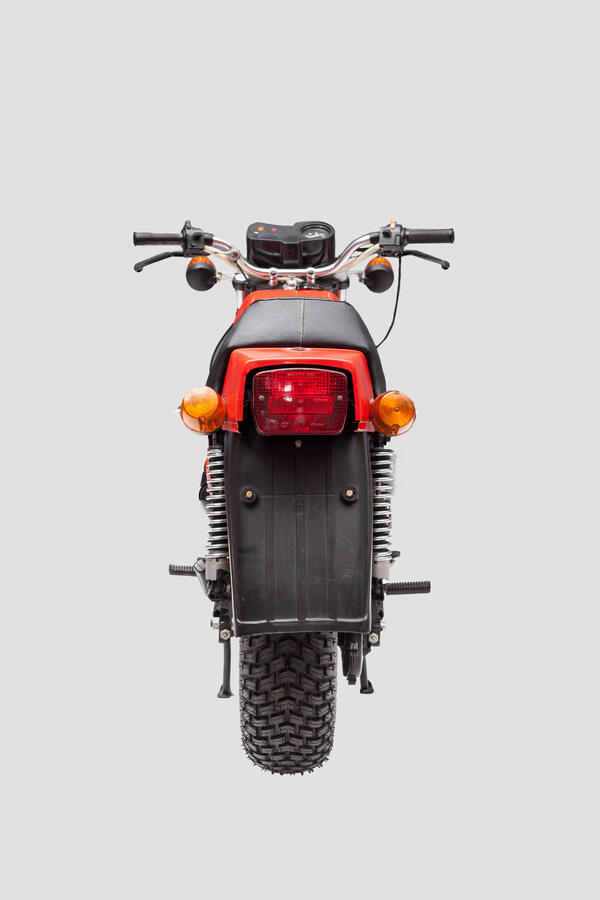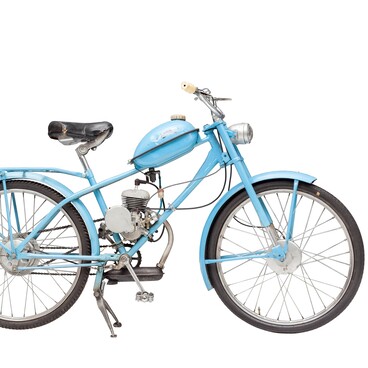The first hundred Tula motorcycles with improved cross-country performance were offered for sale in late 1984. The Tula Machine-Building Plant produced this motorcycle between 1984 and 1996. Initially, the plant was established to manufacture firearms but later it also started assembling bicycles and motorcycles.
The Tula was the first Soviet dirt bike. Moreover, it was the first motorcycle to be equipped with a dynastarter — a device for starting the engine that also generated electricity to power all the electric accessories. The generator was also capable of force starting the air cooling of the engine.
There were two models of this motorcycle: the 5.951 (1984–1990) and the 5.952 (after July 1990). In the later version, the engineers fixed many design deficiencies reported by the users. The use of a dynastarter was associated with high requirements for the starting characteristics of batteries, and no small battery in the Soviet Union could produce the necessary starting current. As a result, it was necessary to use two batteries. In later versions, there was only one battery that was fixed with the help of a wedge made of a hard material, such as foam plastic or wood.
Another drawback of the design was the large width of the tires decreasing the vehicle’s stability in rainy weather. The motorcycle was developed by the design and engineering team of the Leningrad branch of VNIITE, the All-Union Scientific Research Institute of Industrial Design. In the updated version, the engineers reduced the weight by 3 kg, increased the maximum speed from 85 to 90 km/h, and the power from 12.5 to 13 hp.
The motorcycle used a gasoline and oil mix but could also run on the A-76 gasoline alone. It consumed 3.6 liters of fuel per 100 km. The one-piece fuel tank had a capacity of 12 liters, and the 5.951 was equipped with two fuel tanks. The later version was also characterized by a new front fork and a series of small changes that improved the overall comfort.
The Tula TMZ-5.952 was popular among village residents, hunters, and fishermen. Some owners even went on successful longer trips using this motorcycle. The annual production rate was between ten and twelve thousand units.
The Tula was the first Soviet dirt bike. Moreover, it was the first motorcycle to be equipped with a dynastarter — a device for starting the engine that also generated electricity to power all the electric accessories. The generator was also capable of force starting the air cooling of the engine.
There were two models of this motorcycle: the 5.951 (1984–1990) and the 5.952 (after July 1990). In the later version, the engineers fixed many design deficiencies reported by the users. The use of a dynastarter was associated with high requirements for the starting characteristics of batteries, and no small battery in the Soviet Union could produce the necessary starting current. As a result, it was necessary to use two batteries. In later versions, there was only one battery that was fixed with the help of a wedge made of a hard material, such as foam plastic or wood.
Another drawback of the design was the large width of the tires decreasing the vehicle’s stability in rainy weather. The motorcycle was developed by the design and engineering team of the Leningrad branch of VNIITE, the All-Union Scientific Research Institute of Industrial Design. In the updated version, the engineers reduced the weight by 3 kg, increased the maximum speed from 85 to 90 km/h, and the power from 12.5 to 13 hp.
The motorcycle used a gasoline and oil mix but could also run on the A-76 gasoline alone. It consumed 3.6 liters of fuel per 100 km. The one-piece fuel tank had a capacity of 12 liters, and the 5.951 was equipped with two fuel tanks. The later version was also characterized by a new front fork and a series of small changes that improved the overall comfort.
The Tula TMZ-5.952 was popular among village residents, hunters, and fishermen. Some owners even went on successful longer trips using this motorcycle. The annual production rate was between ten and twelve thousand units.




